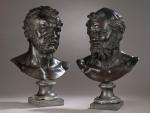La Gazette Drouot, Caroline Legrand

Roman School, second half of the 17th century, Philosopher and Old Philosopher, pair of busts in bronze with a brown patina, h. 42.5 and 41 cm/16.73 x 16.14 in (without the gray veined marble pedestal)
Estimate: €200,000/300,000
Hailing from a chateau in the Loire Valley, this pair of remarkably expressive busts is the work of a 17th century Roman sculptor. Bronzes from the high Baroque period.
While it was the Renaissance that brought bronze back into fashion in Italy, the 17th century provided the technique with its finest masterpieces, prized today by collectors. Of exceptional quality, this pair of never-before-seen busts, which have been preserved for over a century in a Loire château, is a perfect illustration. Cast, as they should be, in lost wax—a process that systematically destroys the mold—these portraits of philosophers reveal extreme mastery: no reparure or casting defects, cold reworking of surgical precision... Each chiseling gives full scope to the expressiveness of the features, even marking the irises with deeply incised semicircles. “The elegance and sophistication of this ‘cold’ work are particularly perceptible in the subtle amati of the transition between the smooth appearance of the skin tones and the deep cuts of the beard and hair,” adds expert Élodie Jeannest. These expressive features and hair styles are strong markers of Baroque art, and more specifically of 17th century Italian art. Previously attributed to Pierre Puget of Toulon, these works were excluded from his catalog raisonné, published in 2023 by Klaus Herding. Today, the attribution is to a Roman artist who assimilated the work of Bernini and l'Algarde. Still a mystery, our sculptor is also said to be the author of two similar pairs, in the collections of the Prince of Liechtenstein and the Hermitage Museum in St. Petersburg respectively. As part of the Counter-Reformation in Rome, the pontifical administration launched major construction projects. This intense activity was mirrored by the civil works commissioned by aristocratic families. Artists often worked for both, but sometimes also for the restoration of antique works, as in the case of Alessandro Algardi, Ippolito Buzzi and Giovanni Antonio Mari. Since these pieces had been an infinite source of inspiration since the Renaissance, they provided models of idealized realism, including bust portraits of thinkers and emperors. The Young Philosopher, for example, has a touch of Caracalla in his face, while the more mature Antisthenes is reminiscent of the founder of the Greek Cynic school. But, turned towards each other, they seem to respond to each other, the older one passing on his knowledge to the younger, according to the Platonic theory in vogue at the time, thus preserving moral virtues.

